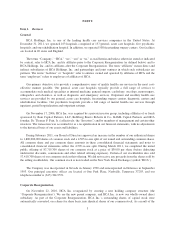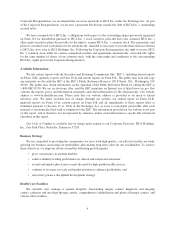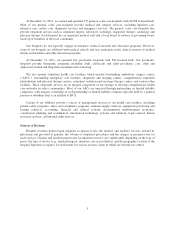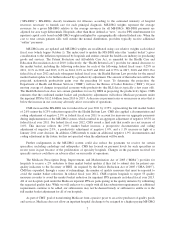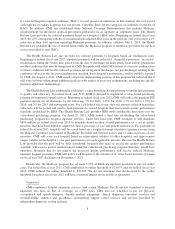HCA Holdings 2011 Annual Report Download - page 10
Download and view the complete annual report
Please find page 10 of the 2011 HCA Holdings annual report below. You can navigate through the pages in the report by either clicking on the pages listed below, or by using the keyword search tool below to find specific information within the annual report.(“MS-DRG”). MS-DRGs classify treatments for illnesses according to the estimated intensity of hospital
resources necessary to furnish care for each principal diagnosis. MS-DRG weights represent the average
resources for a given MS-DRG relative to the average resources for all MS-DRGs. MS-DRG payments are
adjusted for area wage differentials. Hospitals, other than those defined as “new,” receive PPS reimbursement for
inpatient capital costs based on MS-DRG weights multiplied by a geographically adjusted federal rate. When the
cost to treat certain patients falls well outside the normal distribution, providers typically receive additional
“outlier” payments.
MS-DRG rates are updated and MS-DRG weights are recalibrated using cost relative weights each federal
fiscal year (which begins October 1). The index used to update the MS-DRG rates (the “market basket”) gives
consideration to the inflation experienced by hospitals and entities outside the health care industry in purchasing
goods and services. The Patient Protection and Affordable Care Act, as amended by the Health Care and
Education Reconciliation Act of 2010 (collectively, the “Health Reform Law”) provides for annual decreases to
the market basket, including the following reductions for each of the following federal fiscal years: 0.25% in
2011, 0.1% in 2012 and 2013, 0.3% in 2014, 0.2% in 2015 and 2016 and 0.75% in 2017, 2018 and 2019. For
federal fiscal year 2012 and each subsequent federal fiscal year, the Health Reform Law provides for the annual
market basket update to be further reduced by a productivity adjustment. The amount of that reduction will be the
projected, nationwide productivity gains over the preceding 10 years. To determine the projection, the
Department of Health and Human Services (“HHS”) will use the Bureau of Labor Statistics (“BLS”) 10-year
moving average of changes in specified economy-wide productivity (the BLS data is typically a few years old).
The Health Reform Law does not contain guidelines for use by HHS in projecting the productivity figure. CMS
estimates that the combined market basket and productivity adjustments will reduce Medicare payments under
the inpatient PPS by $112.6 billion from 2010 to 2019. A decrease in payment rates or an increase in rates that is
below the increase in our costs may adversely affect our results of operations.
CMS increased the MS-DRG rate for federal fiscal year 2011 by 2.35%, representing the full market basket
of 2.6% minus the 0.25% reduction required by the Health Reform Law. CMS also applied a documentation and
coding adjustment of negative 2.9% in federal fiscal year 2011 to account for increases in aggregate payments
during implementation of the MS-DRG system, which resulted in an aggregate adjustment of negative 0.55% in
federal fiscal year 2011. For federal fiscal year 2012, CMS issued a final rule that results in a net increase of
1.0%. This increase reflects the 2.9% market basket increase, a prospective documentation and coding
adjustment of negative 2.0%, a productivity adjustment of negative 1.0%, and a 1.1% increase in light of a
January 2011 court decision. In addition, CMS intends to make an additional negative 1.9% documentation and
coding adjustment in the future, but has not specified when the adjustment will be made.
Further realignments in the MS-DRG system could also reduce the payments we receive for certain
specialties, including cardiology and orthopedics. CMS has focused on payment levels for such specialties in
recent years in part because of the proliferation of specialty hospitals. Changes in the payments received for
specialty services could have an adverse effect on our results of operations.
The Medicare Prescription Drug, Improvement, and Modernization Act of 2003 (“MMA”) provides for
hospitals to receive a 2% reduction to their market basket updates if they fail to submit data for patient care
quality indicators to the Secretary of HHS. As required by the Deficit Reduction Act of 2005 (“DRA 2005”),
CMS has expanded, through a series of rulemakings, the number of quality measures that must be reported to
avoid the market basket reduction. In federal fiscal year 2012, CMS requires hospitals to report 55 quality
measures in order to avoid the market basket reduction for inpatient PPS payments in federal fiscal year 2013.
All of our hospitals paid under the Medicare inpatient PPS are participating in the quality initiative by submitting
the requested quality data. While we will endeavor to comply with all data submission requirements as additional
requirements continue to be added, our submissions may not be deemed timely or sufficient to entitle us to the
full market basket adjustment for all of our hospitals.
As part of CMS’ goal of transforming Medicare from a passive payer to an active purchaser of quality goods
and services, Medicare does not allow an inpatient hospital discharge to be assigned to a higher paying MS-DRG
7






